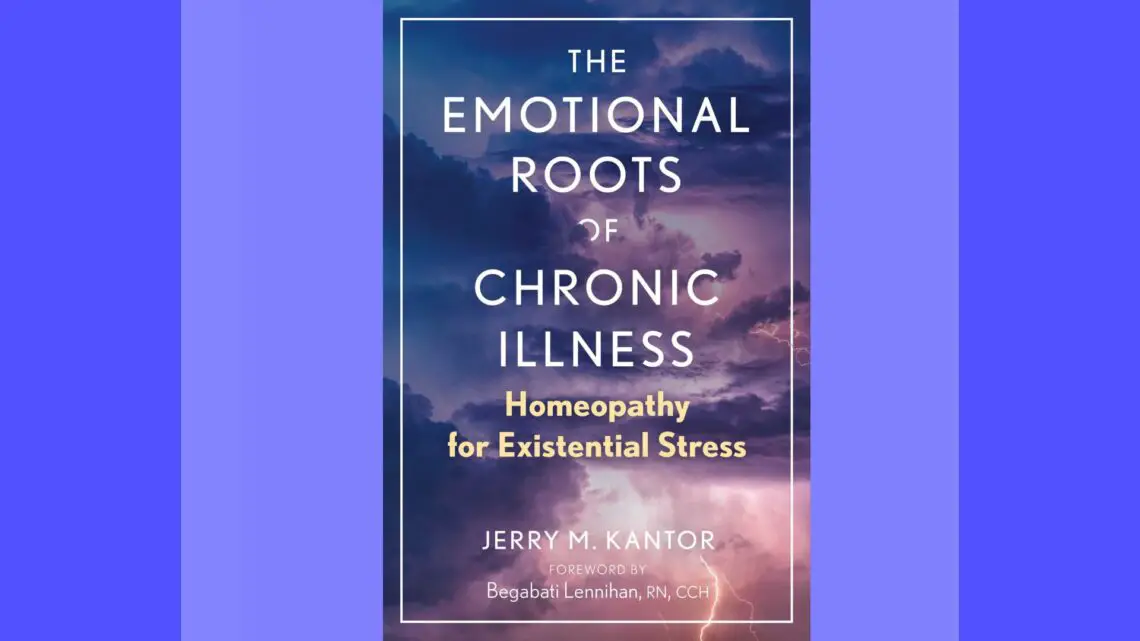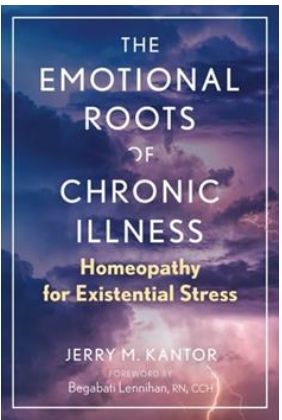Title: The Emotional Roots of Chronic Illness, Homeopathy for Existential Stress
Author: Jerry M Kantor
Published by: Healing Arts press, Vermont, USA
ISBN (print): 978-1-64411-784-2
ISBN (e-book): 978-1-64411-785-9
Year of publication: 2023, paper back, 208 pages
Reviewer: Vatsala Sperling
“By the sweat of your brow will you have food to eat until you return to the ground from which you were made. For you were made from dust to dust you will return” (Genesis 3:19).
How true!!
And there is something else too that is equally true!!
While our sojourn on this earth appears to be a linear journey from dust to dust, it is also our greatest opportunity and time to reflect on the truth about life, relationships, death, creation, and the very meaning and purpose of everything. If we cannot face these questions while we are alive, certainly, we cannot face them at all when we return to dust.
So, let us agree, we are alive for the purpose of trying and hoping to understand why we are given life. This is somewhat similar to the motto of South Carolina, “While I breathe, I hope”. While we breathe, we can hope to ask existential questions and hope to find our answers. Breath is hope, life is hope.
A book like “The Emotional Roots Of Chronic Illness, Homeopathy for Existential Stress” by Jerry Kantor – when you pick it up in your hands with a determination to read it, will ask you to ponder over existential questions while you are alive, breathing, and hoping.
A unique strength of this book by Jerry Kantor is that it tells you something deep about homeopathy without expecting you to read and understand the voluminous tomes of materia medicas and repertories. In fact, you do not need these tools at all to understand what the author is trying to convey to you.
That means, this book is for anyone and everyone who has ever found themselves pondering over life’s meaning and purpose, and you do not have to be a homeopathy practitioner or student at all. “The quest for meaningfulness is ingrained, so we might as well admit that at one time or another each of us become an existentialist” writes Jerry Kantor.
“My notion of existential stress extends beyond what is normally associated with situational disquietude. It encompasses quandaries embedded within our being and becoming. Physical symptoms of existential stress can be rooted in the lineage of the family’s struggle with a particular existential issue. Symptoms thereafter epigenetically evoked express illness susceptibility pertaining to the issue, coded within our genetic profile.”
At this point, I would like to add that there are many ways to use homeopathy. You can take the remedies just to address symptoms. Or you can take the remedies to address the symptoms at the deepest level where the mind, body, and spirit function as one, affecting, influencing, and supporting each other. At this level the remedies have a way of addressing the rift within you at the deepest existential level, and the outcome is, you not only get over your symptoms, but you also experience a lightness in your being as if you have found your answers to life’s most pressing questions and existential themes running down in your family’s lineage.
How does homeopathy accomplish such a feat? Jerry Kantor answers this question, “Homeopathy engages and evokes the subconscious mind. A fully taken case of existential torment featuring constant worry, anxiety, depression, loss of motivation, exhaustion, and diminished social interaction includes physical symptoms that, when interpreted, are windows into subconscious thinking. By signifying an existential ailment’s cause, physical symptoms dictate the course of treatment.” He goes further and connects the existential torments to the cornerstones of homeopathy:
- Synchrony versus isolation (tubercular miasm). Am I alone in life or do I act in synchrony with nature and with others?
- Challenge versus anxiety (psoric miasm). Is my presence in the world sustainable?
- Centeredness versus disorientation (sycotic miasm). Am I oriented in space and time?
- Consolidation versus entropy (syphilitic miasm) Can the boundary between life and death be avoided?
- Creativity versus chaos (cancer miasm). Will the insurrection of my birth prove futile?
Connecting miasms to existential questions is a brilliant move, as miasms are understood to be the epigenetic information we have received from our family lineage going back many, many generations. The founder of homeopathy, Dr. Samuel Hahnemann, explained miasms as “ruts”. Ruts are understood to be the flaws in the soil that makes us, into which the wheels of our life get stuck, and we find ourselves asking “why me?” and other existential questions.
In the chapter “Contextualizing the Law of Similars” you will read one of the most modern efforts at making sense of the fundamental laws of homeopathy, provings, materia medicas, repertories, nano-medicine, and the unique method of producing homeopathic remedies (the process of dilution and succussion that makes homeopathic medicines safe), and the process of case taking that enables the homeopaths to find a remedy that matches closely with your complaint at the level of physical, mental, emotional and even spiritual symptoms. All these, I mean, the A to Z of homeopathy is presented with an admirable simplicity and economy of words.
Psychic excavation is the term the author has used for describing how homeopaths get to the root of the problem during casetaking. He has given brief illustrative cases to show how the well-chosen homeopathic remedies address the deepest angst a person is facing. The remedies discharge the energy contained in that angst and enable the client to move forward in his life, his psychic landscape altered by the energy of the remedy.
Drawing from his understanding of Traditional Chinese Medicine (TCM), Jerry Kantor describes the five basic emotions and how they align with the five phases described in TCM, namely, Fire (joy), Earth (anxiety), Metal (grief), Water (fear), and Wood (anger).
Predating homeopathy and other contemporary forms of medicine by several thousand years, TCM had tapped into a psychological model of using an emotional tool from our inborn toolkit for solving our problems. Elaborating on this toolkit, the author shows how the inability to effectively use the emotional tools like joy, anxiety, grief, fear, and anger lead to expression of symptoms that can be addressed using homeopathic remedies.
Part two of the book is a tour-de-force where Jerry Kantor handles the five existential questions, their corresponding miasms, phases, emotions, and organs.
| Existential question
(MIASM)
|
Sense organ | Emotion
|
Organs
(per TCM)
|
TCM phase
|
Remedies
|
| Am I alone in life or do I act in synchrony with nature and with others?
TUBERCULAR MIASM |
Touch | Joy | Heart-Small intestine | Fire | Aconitum
Apis Arsenicum Belladonna Calc carbonica Mancinella Phosphorus, Rhus radicans, Tarentula and Tuberculinum Koch |
| Is my presence sustainable in the world?
PSORIC MIASM |
Taste | Worry
|
Spleen-Stomach | Earth | Aceticum acidum
Ars album Calc carbonica Camphora Clematis Cobaltum Falco p Kali bichrome Kali bromatum Lycopodium Mezereum Psorinum
|
| Am I oriented in space and time?
SYCOTIC MIASM |
Smell | Sadness
|
Lungs | Metal | Acacia
Alumina Borax Cimicifuga Hydrastis Lachesis Lilium Lithium Natrum mur Natrum sulph Nux moschata Sabina Samarium Senega Sepia Thuja Viscum album Medorrhinum
|
| Can the boundaries between life and death be abided?
SYPHILITIC MIASM |
Hearing
|
Fear
|
Kidney-Urinary bladder | Water | Adamas
Argentum met Aurum met Conium mac Fluoricum acid Mercurius Petroleum Thulium Symphilinum
|
| Will the insurrection of my birth prove futile?
CANCER MIASM |
Sight | Anger
|
Liver-Gall bladder | Wood | Cadmium met
Cicuta virosa Plumbum met Stramonium Veratrum alb Yersinia Carcinocinum |
Though I have summarized the part two of the book in this table above, just to give you an idea what to expect, this section covers the bulk of the book, a total of 127 pages! In this section you will find brilliant inter-connections between TCM concepts, existential questions and the remedies that address them. You will also find the soul of the remedies described in such a manner that when read in all seriousness, you will remember the core description of the remedies for the rest of your life, particularly because some of them include a case example that make a splendid point.
As I come to the concluding chapter, I am convinced that this book will make you think about the existential question that you are facing, how to understand it’s full meaning and purpose in your life and how to find help for moving forward. Jerry Kantor has written a book, as if, specifically for you, so that when you mull over the existential question, you will know in your heart that you are not alone and helpless.
Well done, Jerry Kantor, congratulations to you and many thanks for writing a book that will speak to your readers.






Thank you Vatsala for reviewing and sharing your thoughts and important excerpts from Jerry Kantor’s latest deep, and brilliant book! Thanks Jerry for expanding our homeopathic minds!
I watched The Webinar of Jeremy Kantor at The United to Heal Congress, where he presented his Connection between Miasms and Elements. I disagree with his assignement to Miasms.
In my Opinion the Fire Element in Disharmony has to do with Effort and Sense of Duty. Burnout and Mobbing belong to this. Therefore the Fire Element is connected to the Cancer Miasm.
The tubercular Miasm fits better to the Element Air=Metal and the sycotic Miasm belongs in my mind to Element Wood. Element Wood in Disharmony is Anger which is similar to Inflamation of sycotic Miasm. There are many other hints of these connections. I agree to Jeremy‘s Assingment to Earth=Psora and Water=Syphilitic Miasm.